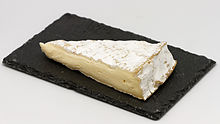| Brie | |
|---|---|
 | |
| Country of origin | France |
| Region, town | Seine-et-Marne |
| Source of milk | Cows |
| Pasteurized | Required in the United States and Australia, not in most of Europe, including France |
| Texture | Soft |
| Aging time | Generally 5 to 6 weeks |
| Certification | AOC: 1980, for both Brie de Meaux and Brie de Melun |
| Named after | Brie |
Preview warning: Page using Template:Infobox Cheese with unknown parameter "regiontown"
Brie (/briː/ bree; French: [bʁi]) is a soft cow's-milk cheese named after Brie (itself from Gaulish briga ("hill, height")),[1] the French region from which it originated (roughly corresponding to the modern département of Seine-et-Marne). It is pale in colour with a slight greyish tinge under a rind of white mould. The rind is typically eaten, with its flavour depending largely upon the ingredients used and its manufacturing environment. It is similar to Camembert, which is native to a different region of France. Brie typically contains between 60% and 75% butterfat,[2] slightly higher than Camembert.[3]
"Brie" is a style of cheese, and is not in itself a protected name, although some regional bries are protected.